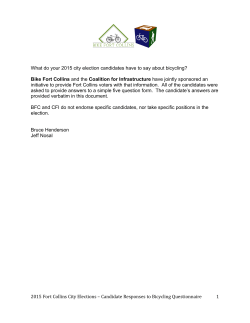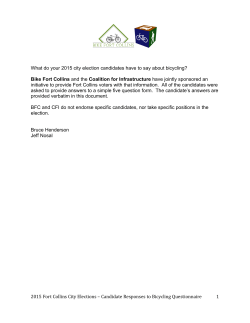
Bike Lane Quick Facts
Bike Lane Quick Facts In a survey of bicycling visitors to North Carolina's northern Outer Banks region, nearly two-thirds indicated that they felt safer riding on bicycling facilities, more than 75% felt that additional bicycle facilities should be built, and nine out of ten strongly agreed that state and/or federal tax dollars should be used to build more bicycle facilities. North Carolina Department of Transportation Division of Bicycle and Pedestrian Transportation, 2004 - The Economic Impact of Investments in Bicycle Facilities: A Case Study of the North Carolina Northern Outer Banks When the city of Seattle removed car lanes and added bike lanes to its Stone Way North street, the volume of cyclists increased 25%, motor traffic on adjacent streets declined 12-34%, speeding decreased 80%, and collisions dropped 14%. City of Seattle Department of Transportation - Stone Way N Rechannelization: Before and After Study Protected green lanes reduce bicyclist injury risk up to 90 percent. Teschke, K., et al., 2012 - Route Infrastructure and the Risk of Injuries to Bicyclists: A CaseCrossover Study A study found that bicycling on separated facilities like green lanes is safer than riding on streets without bicycle facilities. Cyclists were also 2.5 times more likely to ride on the green lanes than on the streets. Lusk, A., et al., 2010 - Risk of injury for bicycling on cycle tracks versus in the street, Injury Prevention, December 1, 2010 From 2000 to 2009, bike crashes in Minneapolis, MN dropped 20%, while the number of city bicyclists increased 174% between 2003 and 2008. City of Minneapolis, 2010, in Flusche, D., 2011 - "Ridership up, crashes down: 'Safety in Numbers' in Minneapolis," BikeLeague.org blog, 9 February 2011 A study of bicyclists in Baltimore, Maryland found that motorists routinely disobeyed a state "three feet to pass" law. Love, D., et al., 2012 - Is the three-foot bicycle passing law working in Baltimore, Maryland, Accident Analysis and Prevention, article in press Bicycle safety improvements attract proportionately more people to bicycling than automobile safety improvements (i.e. a 10% increase in safety results in a greater than 10% increase in the share of people bicycle commuting). Noland, R., 1995 - Perceived risk and modal choice: Risk compensation in transportation systems, Accident Analysis & Prevention, 27, 503-521 After two streets in Minneapolis were converted to be more bicycle friendly, bike traffic increased 43%, total vehicle crashes decreased, traffic efficiency was maintained, and parking revenues remained consistent. City of Minneapolis, 2010 - Hennepin and 1st avenues two-way conversion leads to fewer crashes, better access Cities with high bicycling rates tend to have lower crash rates for all road users. Marshall, W., and N. Garrick, 2011 - Evidence on why bike-friendly cities are safer for all road users, Environmental Practice, 13, 1 After New York City installed a protected green bike lane on Columbus Avenue, bicycling increased 56% on weekdays, crashes decreased 34%, speeding decreased, sidewalk riding decreased, traffic flow remained similar, and commercial loading hours/space increased 475% New York City Department of Transportation, 2011 - Columbus Avenue parking-protected bicycle path preliminary assessment One year after the installation of a protected bike lane in downtown Long Beach, a city survey found an increase in walking and bicycling traffic and a decrease in the number of bicycle and car crashes. City of Long Beach 2013 - Broadway and Third Street Protected Bikeway Study Cities around the U.S. have found that protected bike lanes increase bicycle ridership, reduce motor vehicle speeding, reduce crashes and improve people’s feelings of safety on those streets. Chicago Department of Transportation, July 2012 - Protected Bike Lanes Fact Sheet The majority of bicycle trips are less than 30 minutes in length, although the average distance varies by purpose: Entertainment, recreation, and fitness trips are generally longer, up to 30 or 40 km (18.6-24.9 mi) Work trips tend to be around 20 km (12.4 mi) Trips for shopping and trail access are shorter, under 10 km (6.2 mi) Iacono, M., et al., 2008 - Access to destinations: How close is close enough?: Estimating accurate distances decay functions for multiple modes and different purposes, Report #4 in the Access to Destination Study, Minnesota Dep The number of trips made by bicycle in the U.S. more than doubled from 1.7 billion in 2001 to 4 billion in 2009. U.S. Department of Transportation and Federal Highway Administration, 2009 - National Household Travel Survey From 2000 to 2009, bike crashes in Minneapolis, MN dropped 20%, while the number of city bicyclists increased 174% between 2003 and 2008. City of Minneapolis, 2010, in Flusche, D., 2011 - "Ridership up, crashes down: 'Safety in Numbers' in Minneapolis," BikeLeague.org blog, 9 February 2011 Bicycling in New York City increased 8% between 2010 and 2011, 102% since 2007, and 289% compared to 2001. During the same time, safety increased for all road users. New York City Department of Transportation, 2011 - "NYC DOT Announces Commuter Biking has Doubled in the Last Four Years..." A study of bicyclists in Baltimore, Maryland found that motorists routinely disobeyed a state "three feet to pass" law. Love, D., et al., 2012 - Is the three-foot bicycle passing law working in Baltimore, Maryland, Accident Analysis and Prevention, article in press One year after the installation of a protected bike lane in downtown Long Beach, a city survey found an increase in walking and bicycling traffic and a decrease in the number of bicycle and car crashes. City of Long Beach 2013 - Broadway and Third Street Protected Bikeway Study Cities around the U.S. have found that protected bike lanes increase bicycle ridership, reduce motor vehicle speeding, reduce crashes and improve people’s feelings of safety on those streets. Chicago Department of Transportation, July 2012 - Protected Bike Lanes Fact Sheet
© Copyright 2025





















